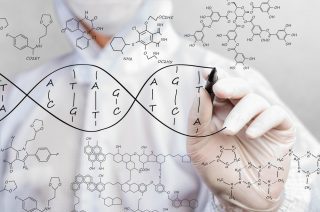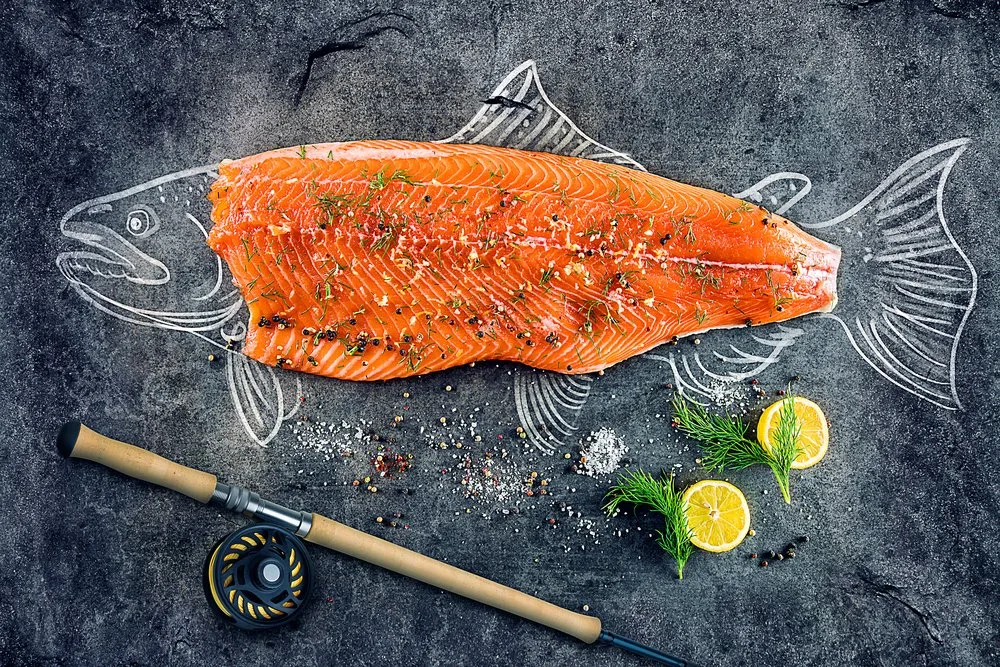Independence Day meals are always a treat. Salmon is a popular, healthier choice for a barbecue, picnic or celebratory dinner meal. That said, there is one growing question in terms of salmon. Consumers are beginning to wonder if they should be adding genetically modified salmon or “Frankenfish” to their shopping carts? And while genetically engineered salmon sounds more like something from a sci-fi movie, it’s very real and coming to your store.
Why Frankenfish?
The term frankenfish is used to refer to genetically modified salmon. It got its name from a 2004 American horror film. The film featured a genetically engineered fish in the bayou. The inspiration came from a snakehead fish incident in Crofton, Maryland. Movie thoughts aside, regulations surrounding genetically engineered (or GE) foods are changing quickly. In fact, the FDA is now approving its sale in stores in the US. So whether you call it salmon or frankenfish, you will most likely find it in U.S. stores soon.
From Atlantic Salmon to Frankenfish

This was an interesting and profitable science experiment. According to PBS, a research team from Memorial University of Newfoundland, Canada – led by Dr Garth Fletcher – realised that when applied to Atlantic salmon, molecular genetics had a profound increase in the growth of the fish. Their studies showed that, during specific times of the year, the growth hormones in salmon have peak active periods. Fletcher set out to find out how he could get these hormones to stay active throughout the year. Therefore, it is increasing its growth rate.
A Scientific Breakthrough
The breakthrough came in the form of extracting a special protein from an ocean pout that allows it to exist in the freezing waters near Canada. Using DNA that allows this protein to stay switched on, Fletcher then connected this to the growth hormone in the salmon. The genetically modified salmon was born due to the team’s ability to successfully keep the growth hormone running.
This growth hormone has reduced the time it takes to get to market from three years to 18 months. Fletcher patented GE technology and founded Aquabounty in 1991. Today, the AquaAdvantage Salmon grows not only non-stop but at a faster rate than farm-raised Atlantic salmon. In addition, it requires less feed to get to market size.
What are the Long Term Health Effects?
However, this begs the question: Do we know what the long-term health effects of eating GE animals will be? How about the impact on the environment, on the animals themselves, their offspring?
What about the ethical aspect of manipulating the DNA of another living creature?
Bio-engineering Food For Human Consumption Is Not New.
You have probably already eaten genetically engineered (GE) plant-based foods – unless you grow your own food on a farm far removed from the rest of society. According to the Center for Food Safety, it is estimated that up to 92% of US corn is GE, along with 94% of soybeans and the same percentage of cotton. Go to a supermarket in the US, and about 75% of processed foods on the shelves will contain GE ingredients.
“Frankenfish” vs. market approval

Four years after the company was founded, Aquabounty applied to the FDA for approval of their product. PBS relates that, back then, the move was met with opposition on a large scale. Scores of retailers chose not to sell genetically modified salmon. The FDA also received millions of comments from protestors.
According to CNN, it was only twenty years later that the FDA approved the AquaAdvantage salmon from Aquabounty. This was despite more opposition from the public. In a statement, they pronounced it safe to eat. They said that the introduced DNA was safe for the fish itself. They also maintained that the salmon met the sponsor’s claim about faster growth.
FDA has Been Considering Modified Salmon For Some Time
The FDA also announced that the modified salmon and process had no significant impact on the environment. One area of evaluation that happened was the guidelines informing consumers of the GE make-up. Thus, the US Congress prevented the FDA from selling the fish. In 2016, the FDA implemented an import alert. What did this mean? The FDA was not allowed to introduce or deliver any foods containing GE salmon into interstate commerce, including their eggs.
Labeling of GE Salmon
The decision came with Congress’s enactment of the National Bioengineered Food Disclosure Standard. It divested the FDA from its authority over voluntary labelling to indicate the presence of GE content in human food. In its place, the USDA was charged with implementing a mandatory standard for disclosing whether a food is “bioengineered”. This requires manufacturers, importers and certain retailers to indicate whether a product was bioengineered using either text, a symbol, an electronic or digital link, and, or a text message.
Indiana Is the Home of Salmon Eggs
In an official statement, the FDA pronounces AquaBounty Technologies’ AquAdvantage Salmon as the only GE animal for food use that currently has FDA approval for its alteration. This also means that AquaBounty Technologies is now able to sell food derived from its GE salmon in the U.S. The company may now also export GE salmon eggs to an FDA approved United States facility in Indiana where they will be raised into adult fish.
AquaAdvantage Salmon could be in US markets by next year
In Canada, the “Frankenfish” has had the stamp of approval from the Canadian government since 2016. Competitors shared their outrage at the launch. Canada has no regulations that require GE salmon labelling. What does this mean? Unbeknownst to you, you may be eating a genetically modified fish. For many, this is a big problem.
What are the Long Term Health Effects?
Sharon Labchuk from the environmental group Earth action expressed concern over the fact that no-one really knows what the health impact will be on people who have been eating the fish for years. Labchuk has been fighting GE salmon being sold in Canada for decades. “We’ve had, say, 20 years or so of experience in Canada of genetically engineered plant foods. We really don’t know what the health effects are. People should have the right to have their fish labeled. And they should have a right to know whether they’re eating genetically modified salmon.”
Friends of the Earth, a U.S. environmental activist organization, told CBC the move was “flawed and irresponsible.”
Many Grocery Chains Will Not Stock the Fish
The group said more than 60 grocery chains representing more than 9,000 stores in the U.S. have committed to not selling the salmon, adding that 1.8 million people have sent letters to the FDA opposing the product’s approval.
“It’s clear that there is no place in the U.S. market for genetically engineered salmon,” said Lisa Archer, the organization’s food-and-technology program director. “People don’t want to eat it and grocery stores are refusing to sell it.”
The organization also wants to see the product labelled as a genetically modified organism.
The FDA does not ask for the mandatory labelling of AquaBounty salmon. Why? Because it is not materially different from other Atlantic salmon. However, the FDA has included guidance documents should manufacturers opt for voluntary labelling.
The Why Behind GE Salmon

Firstly, the seafood industry is highly overtaxed, and with the global population that keeps on growing, and with people eating more and more fish in the years to come, there is going to be an even bigger demand on the industry to produce. Speaking to PBS, Ron Stotish – the chief technology officer of Aquabounty – said this: “We’re going to run out of land, and run out of water to do what we’re continuing to do, unless we find a better way to do it.”
Atlantic Salmon Faces Endangerment
Most of the Atlantic salmon currently being consumed in the U.S. has to be imported from ocean farms in Chile, Norway and Canada, according to PBS. Because wild Atlantic salmon are endangered, you can only sell the fish by ocean farming it. Catching it is illegal.
Only a few places permit the practice of ocean farming. Stotish explained that when fish grow a bit faster than they do naturally – as is the case with frankenfish – they can be grown in a land-based aquaculture facility. This then greatly broadens the options of where they can be grown.
Environmental Impact

Strange as it may sound, frankenfish could be good for the environment. Most salmon has to be imported. That said, Atlantic salmon unfortunately comes with a significant carbon footprint. By setting up land-based aquaculture facilities closer to consumers, you can reduce transportation costs. You can also reduce your carbon footprint, explains Stotish. The estimates made by Aquabounty show that their carbon footprint would be 23-25 times less than that of traditionally farmed salmon.
Other Risks Associated With GMO Fish
Then there’s the factor of escape. To counter this, stringent safety measures have been put in place to ensure that the AquAdvantage salmon is unable to escape the facilities where it is being grown.
In a statement, the company defended this, saying, “Our AquAdvantage® Salmon will be raised in land-based production systems away from the ocean, eliminating the risk of escapes that could impact native fish populations AND the risk of pollutants or contaminants that could harm marine ecosystems. Our salmon will be raised in optimized conditions with total control of the water coming in and going out, which will allow for removal of waste and the recycling of greater than 95% of the water used. AquAdvantage® Salmon production systems will be operated at relatively low densities, so as to optimize fish health and minimize the environmental impact of the production system.”
Not only are they microchipped, but each AquAdvantage® Salmon is also trackable. As a result, if a fish does escape, the company will be able to find them in the wild.
The Future of GE foods
There is a growing demand for more GE foods to be included in the U.S. markets.
The world population is growing at a frightening rate. Therefore, one of the major challenges humanity faces is the threat of food scarcity. This is weighed up against the modification of food, whether seeds, plants and now fish. Due to human needs, food manufacturing is being ramped up to produce food in much bigger quantities.
Yes, there is a threat of food scarcity. However, mass food production is increasingly placing our health outcomes at risk.
Genetic Modification Is Getting Easier
In early June this year, President Trump signed an executive order that resulted in the simplification of regulation and its complexities by federal agencies for producers. According to the Chicago Tribune, at the same time companies are bringing in newer genetic engineering techniques, which enable scientists to alter the DNA of plants and animals in an easier way than before.
The USDA has suggested a change in its regulations. This may result in much of the GE soy and corn that is currently being grown in the US that would not necessarily be subject to special oversight. However, according to Jaydee Hanson of the Centre for Food Safety, gene editing has the potential to be used for more significant changes – including those that would never happen in nature – and therefore oversight is necessary.
Faith Versus Science
“Some of this is what I call a faith-based approach, and not a science-based approach to regulation. They have faith that none of these things are going to cause any problems,” Hanson said.
According to the World Health Organisation, the main issues of concern for human health when it comes to GMO foods include allergenicity, gene transfer and outcrossing. However, they list a number of genetically modified organisms that can be expected in the future, including plants that have improved resistance against plant disease or drought, as well as crops that have increased nutrient levels.
Some U.S. States Will Not Accept Frankenfish
The “Frankenfish” story will continue to be a source of debate among activists. At a state level in the U.S. Willits News reported back in 2014 that California Governor Jerry Brown had signed a bill by Assembly member Wesley Chesbro that protects California’s native salmon and steelheads by banning commercial production of genetically altered, or “transgenic,” non-native salmon: “I thank Governor Brown for understanding the importance of protecting California’s wild salmon and steelhead from the threat of transgenic modification,”
Cultivation and Protection
He added, “If these “Frankenfish” were to escape into our waters, they could destroy our native salmonid populations through interbreeding, competition for food and the introduction of parasites and disease. The only way to ensure this never happens is to ban commercial hatchery production, cultivation or stocking of transgenic salmonids in California.”
Dangerous Loophole
In another report, the Center for Food Safety said it “cautiously welcomed” the new legislation. However, they’ve said that a “dangerous loophole” must be closed.
“California has taken has taken an important step to protect its native salmon and trout stocks,” said the group’s West Coast director Rebecca Spector. “Genetically engineered salmon pose a serious risk to our waterways and our native fish populations.” The bill expands a 2003 law to include all waterways within the state of California. Unfortunately, it opens up a loophole for research that could lead to dangerous fish escapes.
Conclusion
There is a growing demand for fish. Unfortunately, the threat of overfishing looms on. Genetically engineered salmon may well be able to help meet this growing demand. However, many health and environmental activists are concerned this approach has potentially dangerous consequences for the econology and economy of humanity. With the growth in lifestyle-related diseases increasingly associated with mass food production, the idea of genetically modified salmon is daunting.
We have been told to eat salmon as it was a fish that roamed free and wild in the ocean. Many of its health benefits are as a result of this. Thus, can a genetically modified fish, mass produced in a controlled environment really have the same health benefits as one roaming free?
Labeling is not Mandatory
If authorities are letting GMO salmon swim through, then consumers have the right to know what they are eating. Unfortunately, the FDA does not require the mandatory labelling of AquaBounty salmon. This is because it is not materially different from other Atlantic salmon. The FDA has included guidance documents should manufacturers opt for voluntary labelling.
Consumers should be concerned that authorities are leaving this door so open. Come the next 4th of July, you may not be able to know the difference between salmon and GMO salmon. You may also be raising your Independence Day celebrations to “Frankenfish.”
Did you know?
Salmon is one of the healthiest forms of protein that you can have in your diet. It’s a major source of Omega-3 fatty acids, B Vitamins, potassium and selenium. The ketogenic diet includes salmon as one of its main sources of seafood protein. Click on the link to find out more about our top 10 Keto foods, ideal for when you want to lose fat and build muscle.
This article was co-written by Johané du Toit and Gisèle Wertheim Aymés



![women [longevity live]](https://longevitylive.com/wp-content/uploads/2020/01/photo-of-women-walking-down-the-street-1116984-100x100.jpg)










